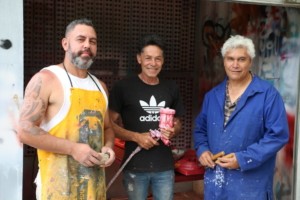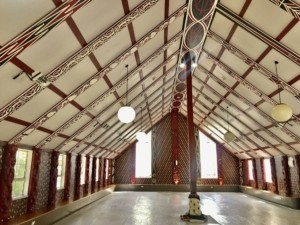
For 2.5 years Charles Paringatai, Emanuel Dunn and Te Rangi Robin (from left) were working on the carvings.
 After 2.5 years of designing, painting and carving, the new pou, kōwhaiwhai and tukutuku for EIT’s wharenui, Te Ara o Tāwhaki, were officially revealed and blessed on 12 February. Over 160 people joined the dawn ceremony which by tradition commenced at 4 am.
After 2.5 years of designing, painting and carving, the new pou, kōwhaiwhai and tukutuku for EIT’s wharenui, Te Ara o Tāwhaki, were officially revealed and blessed on 12 February. Over 160 people joined the dawn ceremony which by tradition commenced at 4 am.
The marae was officially opened on 29 October 1994. Director Māori Tuhakia Keepa said that when the wharenui was officially opened, it was always with a view of completing the interior.
In 2017, Tuhakia and Te Ūranga Waka’s head Puti Nuku jointly identified who might be included in the project. As the faculty’s first dean, recently appointed Adjunct Professor Joe Te Rito commissioned carvers, including Te Rangi Robin, to design and work on pou whakairo for the exterior of the wharenui and paepae (threshold) as well as other structures on the marae. Te Rangi was joined by Emanuel Dunn and Charles Paringatai.
The carvers were based at EIT’s IDEAschool, where – over the last 2.5 years – they created a total of 40 carved panels. Traditionally, pou whakairo depict ancestors. However, because EIT is an educational institution, Te Rangi says a different concept has evolved.
Half the carvings represent Māori gods while others represent decades and achievements made for Māori during those times. Some also reflect current social issues relevant for the area as well as topics related to EIT. The result is like a storybook, with the interior of the wharenui to be read in tukutuku (woven lattice-work), kōwhaiwhai (painted panels) and pou whakairo.
IDEAschool lecturer Raewyn Paterson was the mastermind behind the contemporary take on the traditional tukutuku. She had invited the whole community to join in the creation of the poutama and pouhine patterns made from thousands of wooden pieces. Cody Hollis, on the other hand, designed the kōwhaiwhai or painted panels which embellish the ceiling of the wharenui.
Te Ūranga Waka is also excited to announce that on 28 February the new and expanded contemporary learning spaces will be opened to the students. They are replacing the former transportable buildings and are able to accommodate the growing number of students. “There are two new blocks. One includes an art room where we will also hold traditional greenstone carving courses, and the other one has two classrooms separated by a removable wall that allows us to create a collaborative learning space,” explains Head of School Puti Nuku.
